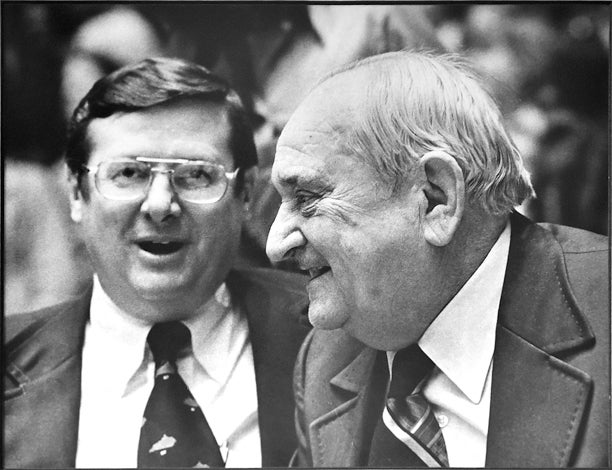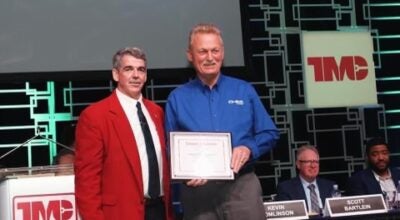Former Sun staffer Jerry Linville remembered for kindness, talent
Published 12:58 pm Saturday, October 21, 2017
An obituary seldom serves as more than a postscripted resume, a timeline of achievements we’ve logged between birth and death. The final line of Jerry Linville’s obituary, however, serves as a succinct summary of the quality of his character.
“Jerry was a good and kind man.”
Penned by his sister, Kathleen Linville, the epitaph was as to the point as the man himself.
“I added that because he really was a very good man and a very kind man,” Kathleen said of her sibling. “He was so good to me. He did everything for me after our parents died.”
Jerry Linville died Monday at Clark Regional Medical Center. He was 80.
Funeral services and his burial at Winchester Cemetery were Friday.
He never married and shared the family’s downtown home with his sister. Their father, Orville Linville, died while Jerry was in high school.
Jerry felt a sense of duty to provide for his family and went to work, Kathleen said, and took a job at The Winchester Sun. It was the only place he would work during his nearly 50-year career.
A hobby from his youth helped set the course of his professional life. He learned photography, oddly enough, in his backyard in a chicken coop.
“Years ago, everyone had chickens,” Kathleen said. “Jerry wasn’t very old, but he would go out and take pictures.”
Later, Jerry would repurpose the coop.
“He would close the windows and door and started developing film,” Kathleen said. “He turned it into a darkroom, and he became pretty good at it. Several of his pictures got published in the paper.”
His first job at the Sun was far from photography. He oversaw the crew of paperboys, handing out pre-counted bundles of papers to them from basement windows on the side of the Sun’s building.
As they waited on the presses, the young carriers would carve their names into the bricks fronting Cleveland Avenue. Jerry also added his name to the etched roster.
“Jerry was a great guy,” retired Sun publisher Betty Berryman said. “You could always depend on him. If he had a headache or a back ache, he came to work. He was an ideal employee.”
Bob Martin, who was a circulation manager before becoming the Sun’s production manager, also praised Jerry.
“He was always on deadline,” Martin said. “He was always a man of his word. I don’t think he ever missed a day of work. He was a person that would take time to teach anyone the newspaper business. He always had time for others. He was a great man, and a great friend.”
During his career, Jerry would learn more of the skills necessary for putting out a newspaper, such as setting type. During the days of hot lead typesetting, newspapers were composed on Linotype machines. Type was placed in a locking metal frame, or chase, and placed on a turtle, which was a metal cart on wheels. At the Sun, typesetting was done upstairs, and the chases were transferred to the pressroom via a freight elevator.
That’s a great plan when the elevator is waiting, but when it isn’t a turtle pushed toward the elevator shaft on deadline is a recipe for disaster, according to a story Jerry recounted for numerous newsroom rookies he mentored.
“When it hit the floor, the type scattered everywhere,” Jerry said. “We learned it was faster to set it the second time.”
Despite the setback, the presses still rolled on time, he said.
Ann Laurence, a former Sun advertising manager, also had praise for Jerry’s work ethic.
“He was dedicated to making the Sun the best it could be,” said Laurence, who retired as the publisher of The Richmond Register. “He was always meticulous about the details. And he was loyal.”
Throughout the years, printing technology changed. Cold type and paste-up replaced the Linotype machines, and those processes gave way to pagination and page-sized image setters.
“I saw the writing on the wall,” Jerry said. “I figured I better learn pagination if I wanted to keep my job.”
And for years following his move from the composing department to the newsroom, that’s what he did — put together many of the Sun’s inside news pages. He brought over many of the old typesetting skills with him. He was careful with spacing, breaking columns, widows and orphans and leading.
Many of the old tools, like pica sticks and razor blades, gave way to software replacements.
Jerry adapted, and soon developed his own strategies for processing digital photos in Photoshop. He made grainy photos pop, instinctively knowing how to set brightness, contrast and sharpness.
Those skills were not learned in a book. They came from years Jerry spent photographing sporting events and some on-the-side work.
“When I started at the paper, I knew how to take a photo but he taught me how to be a photographer,” said former Sun photographer James Mann. “I was working for quite a while before he told me he really liked one of my photos. It meant a lot coming from Jerry.”
For years, many of Jerry’s class black-and-white works adorned the newsroom walls. The portraits of sports legends like Paul “Bear” Bryant and home run king Hank Aaron were conversation starters. He also photographed University of Kentucky coaches Adolph Rupp and Joe B. Hall, and boxing legend Muhammad Ali.
“I believe he was a natural at photography,” Mann said. “He had a great eye for photos, a love of photography and a good understanding of the sports he was photographing. Jerry’s timing for taking photos was unreal.”
His celebrity works drew notice outside of Winchester, Kathleen said.
“Jerry had a photo of Joe B. Hall and Coach Rupp together,” she said. “Coach Hall called and wanted a print of the photo. He said it was the best picture ever taken of him.”
Several of Jerry’s works are now housed at the Bluegrass Heritage Museum on Main Street in Winchester.
The celebrity shots were a miniscule number of assignments. High school and youth sports were his main beats, and years of travel following Clark County teams across the state took their toll on his health, and his banged-up, much maligned red Chevrolet Chevette. As pieces of trim fell off and sheet metal loosened, more and more duct tape was used to keep it together.
Jerry and the car were an appropriate match. Both were worn, but always willing to take on more responsibility. Both were efficient, tacking on thousands of miles to their frames. Both smoked — oil for the Chevette and cheap cigars for Jerry, a habit which helped cement his stereotypical newsroom curmudgeon persona.
At first appearance, Jerry could be intimidating to the newsroom cubs who passed through the Sun early in their careers. He was 6 feet tall, bald and broad-shouldered. When he was on deadline, stressed for time, his focus narrowed and there was no time for talking. Once the pressure was off, he transformed into the newsroom cut-up, often serving as the foil to former editor Bill Blakeman and good naturedly sparring with Jeff Kerr, the one-time sports editor.
“I always laugh thinking about he and Jeff Kerr verbally poking at each other,” said Matt Coy, a managing editor at IMG/HOST Communications who worked at the Sun early in his career. “Overall, I think about being a kid fresh out of college trying to stay afloat as the sports editor at a daily newspaper. There were times I absolutely felt in over my head. But people like Jerry, Jeff, James Mann, Betty Smith and Bill Blakeman … were so helpful to me and were always happy to give advice. And I’ll always be grateful for it.”
Jerry’s wit was sharp, and sometimes dark (newsrooms are notorious for fostering gallows humor). He once explained a past side job photographing the deceased at funerals.
“A lot of people would want photos from the funerals,” Jerry said. “It was an easy job. I would go in, set up my camera and say, ‘Don’t move!’”
But even that was part of his ruse. He used the surly, cigar-chomping, poker-playing grumpiness to mask his kindness to others.
“Jerry was very tender hearted,” Berryman said. “One day, I was having pains across my shoulder. It hurt so bad tears were running down my cheek. Jerry saw me and popped into my office. He said, ‘Betty, I’m going to call the chiropractor and we’re going to get this taken care of.’ He did. He wanted to help me. He was that kind of guy.”
But after 49 years, Jerry brought his newspaper career to a close on Oct. 31, 2002. He would talk about waves of new technologies being implemented, including online services, in sometimes disparaging tones.
“It’s just time,” he said of his decision. He was gently ribbed that he would return to the Sun often, but Jerry insisted he had had enough.
When he left, he only made a handful of appearances in the front office, usually to see to a paper delivery issue.
He gave up the newspaper life, but not his humanity. Jerry was known to help his friends if there was ever a need. Taking an elderly man clothes shopping at Walmart, and taking another fishing were commonplace, if not widely known.
But Jerry’s true soft spot was his love of animals.
“Our father and grandfather would go hunting and take Jerry along,” Kathleen said. “He would go and never kill anything. He would shoot the wrong way on purpose.”
Once the Sun’s pages were sent to the pressroom, Jerry would make a beeline to a filing cabinet in the composing room. It was there he kept ears of cracked corn he used to stock squirrel feeders he had placed on oak trees that once stood near the back entrance of the courthouse.
He was also fond of dogs and cats. A favorite among his pets was Walter, named for James Thurber’s daydreaming character Walter Mitty. Jerry contributed money, supplies and time to animal welfare groups and the animal shelter.
H.B. Elkins, the former editor of the Citizen Voice and Times in Irvine, knew Jerry as a colleague in the newspaper industry and later as a booster for animal welfare causes. Elkins’ wife, Melissa, was a reporter and design editor at the Sun who was involved in spay and neuter programs and rescues.
“They bonded pretty quickly, in large part because they shared a love of animals,” H.B. said of Jerry and Melissa. “… He was always supportive of Melissa’s work to improve the shelter and her efforts to promote the spaying and neutering of pets to prevent overpopulation, and the resulting euthanizations the shelter would have to do because it didn’t have room for all the unwanted pets.
“Jerry may have had what appeared to be a gruff exterior sometimes, but he had a heart of gold. I know Melissa will always treasure her friendship with him as one of her overriding memories of her time at the Sun.”
To honor the memory of this good and kind man, contributions to the Clark County Animal Shelter have been requested. The shelter’s address is 5000 Ironworks Road, Winchester, KY 40351.
David Stone is a former editor at the Sun, and one of the many who has benefitted from Jerry Linville’s kindness.






